Hasegawa 1/72 F-102 Delta Dagger
|
KIT #: |
JS-047 |
|
PRICE: |
£5 when it was
new way back when |
|
DECALS: |
Two options |
|
REVIEWER: |
Carmel J. Attard |
|
NOTES: |
|
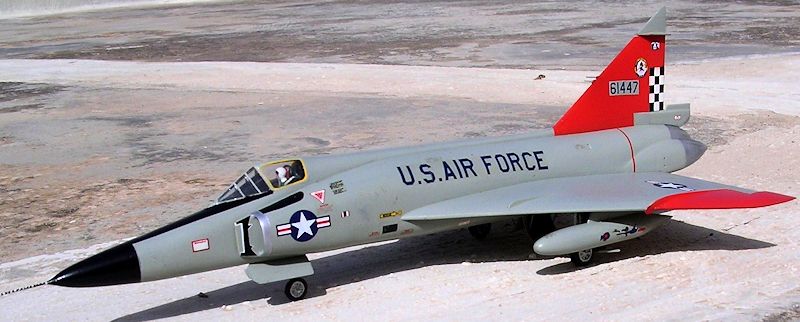
A follow up to the design of the
Convair Delta
XF-92, as part of the F-92 programme back in 1948,
a Convair design known as Model 8 won the USAF design competition in 1950. It
was a scaled up in size of the Delta.
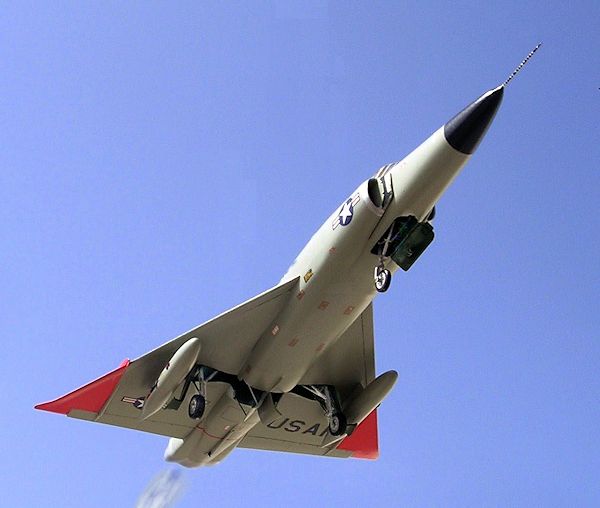 Two
prototypes YF-102s flew respectively on October 24th
1953 and January 11th 1954. Initial
trials showed deficiencies in the high-speed performance. The YF-102A was
developed and flew in December 1954. The production model F-102A was similar and
975 were built for service with Air Defence Command starting in mid 1956. The
USAF also purchased 111 TF-102s with a two seat side-by-side, which first flew
on November 8th 1955. By 1970, only
four USAF regular squadrons flew the F-102A but 13 Air National Guard squadrons
were equipped with the type. During the 1969-70 many F-102As were transferred to
the Greek and Turkish Air Forces.
Most of the remaining airframes were expended as QF-102 Drones.
Two
prototypes YF-102s flew respectively on October 24th
1953 and January 11th 1954. Initial
trials showed deficiencies in the high-speed performance. The YF-102A was
developed and flew in December 1954. The production model F-102A was similar and
975 were built for service with Air Defence Command starting in mid 1956. The
USAF also purchased 111 TF-102s with a two seat side-by-side, which first flew
on November 8th 1955. By 1970, only
four USAF regular squadrons flew the F-102A but 13 Air National Guard squadrons
were equipped with the type. During the 1969-70 many F-102As were transferred to
the Greek and Turkish Air Forces.
Most of the remaining airframes were expended as QF-102 Drones.
In my
records there is at least one occasion an F-102 has visited Hal Far airfield way
back in December 9th 1959 but I
believe there was another occasion when F-102s visited the island of Malta.
These used to transit from Wheelus air base in Libya that had at that time a big
firing range used by the USAF.
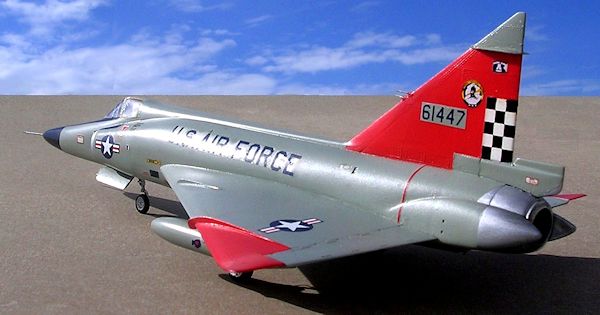 This is
a Hasegawa kit; an old kit but is accurate in shape and outline. It is devoid of
panel lines and has raised ones instead. It also lacks certain detail in
particular to the nose wheel areas and bay inside detail. Landing gear was not
quite accurate to my liking and I preferred to replace with the metal landing
gear issued by SAC. Set SAC 72-2056 has an accurate straight nose gear leg and
nose gear wheel well detail. Some alterations may be required to fit the metal
undercarriage legs, which is self explained in the attached scrap views.
This is
a Hasegawa kit; an old kit but is accurate in shape and outline. It is devoid of
panel lines and has raised ones instead. It also lacks certain detail in
particular to the nose wheel areas and bay inside detail. Landing gear was not
quite accurate to my liking and I preferred to replace with the metal landing
gear issued by SAC. Set SAC 72-2056 has an accurate straight nose gear leg and
nose gear wheel well detail. Some alterations may be required to fit the metal
undercarriage legs, which is self explained in the attached scrap views.
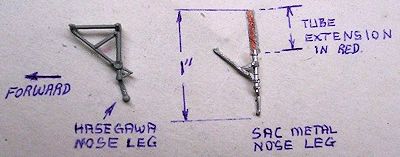 The
kit contains a complete weapon bay that has extended launch rails for six Falcon
AA missiles. These missiles are not accurate in shape and need replacement with
more accurate ones with added hinges to the
The
kit contains a complete weapon bay that has extended launch rails for six Falcon
AA missiles. These missiles are not accurate in shape and need replacement with
more accurate ones with added hinges to the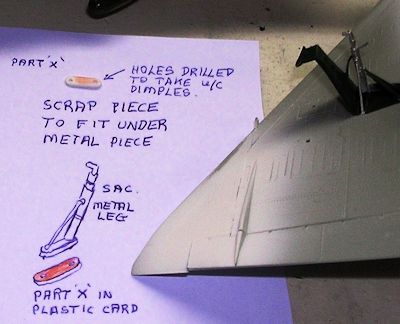 ir
control fins. I have preferred to assemble my F-102 with a closed weapon bay.
Again there is a drawback in this case as the bay doors have a thin section and
would require spaced bulkheads or complete replacement with one built up from
thick plastic. I have opted to support them from the inside with spaced
bulkheads made from plastic and retained the same weapons bay doors.
(Editor's note: I seem to recall that someone did or does a cast metal
replacement for the doors on this kit, but do not recall who it was/is.)
ir
control fins. I have preferred to assemble my F-102 with a closed weapon bay.
Again there is a drawback in this case as the bay doors have a thin section and
would require spaced bulkheads or complete replacement with one built up from
thick plastic. I have opted to support them from the inside with spaced
bulkheads made from plastic and retained the same weapons bay doors.
(Editor's note: I seem to recall that someone did or does a cast metal
replacement for the doors on this kit, but do not recall who it was/is.)
The
cockpit office was not to the same standard of Hasegawa offering that we find
today and for anyone who add a crew figure finding a more accurate replacement
one is recommended. A
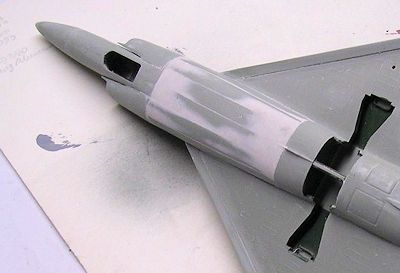 more
prominent radar hood was added to the cockpit coaming. The kit pitot tube was
too thin and fragile, and was replaced with one made of metal. Finally a slight
alteration was made to the wing tips to conform in shape to the close up photo I
had of same version.
more
prominent radar hood was added to the cockpit coaming. The kit pitot tube was
too thin and fragile, and was replaced with one made of metal. Finally a slight
alteration was made to the wing tips to conform in shape to the close up photo I
had of same version.
On a
previous occasion I also converted a similar kit into a TF-102 trainer version.
I converted the forward fuselage and nose area by replacing the single seat nose
section with the one provided by Airmodel set AM-131. This conversion set simply
contained a two-part vac form forward fuselage in white acetate and a
corresponding cockpit canopy.
This
is intended for the Hasegawa kit however it is very basic and all the interior
cabin detail had to be scratch built including the rear bulkhead, two crew seats
and side consoles, coaming, instrument panel, control columns etc. Air intake
plates were also added to separate the intakes from the cockpit. Tiny square
pieces to simulate vortex generators were added to the windscreen periphery. Air
intakes also needed rework to bring to shape as the ones mounted on the TF-102.
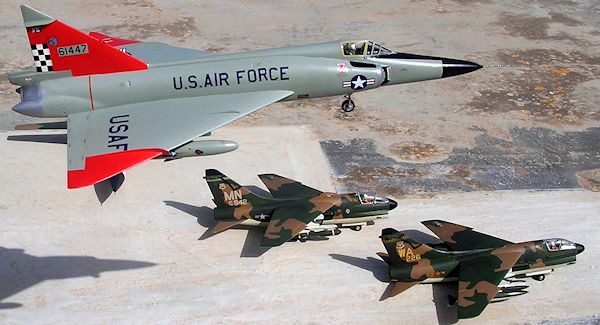 The
F-102 rakish lines and broad surfaces lent themselves to the application of
interesting and color markings. The F-102 looked good in whatever it wore. This
was however a point quickly argued by many in view of the introduction of
camouflage.
The
F-102 rakish lines and broad surfaces lent themselves to the application of
interesting and color markings. The F-102 looked good in whatever it wore. This
was however a point quickly argued by many in view of the introduction of
camouflage.
Nearly
all F-102s came from factory painted overall glossy aircraft grey (FS16473)
often called “Air Force Grey” but best known as ADC Grey. The natural tone
became the Air Force standard, which not only presented a uniform finish but
protected aircraft surfaces. Its application to the F-102 was vital in shielding
the interceptor’s skin from the rocket blast of Falcon missiles.
Residue
from the missile’s rocket motor was inert until it got wet, then moisture
triggered an electrolytic corrosive action that broke down the metal alloys. To
ensure adequate protection the F-102 was given a coat of wash primer and a coat
of zinc chromate primer, followed by high-grade enamel. Magnesium components
received an extra undercoat of zinc chromate, while titanium parts remained
unpainted.
Duces as
the F-102 are also known that operated over the northern snowy regions featured
large red-painted areas of maximum conspicuousness in the event they were forced
down. Red-tailed units were the Alaska-based 31st
and 317th Fighter Interceptor
squadron, the 37th in Vermont, and
57th in Iceland, the 59th
in Labrador, the 327th (when it
deployed to Greenland) and the Wisconsin and Minnesota ANG.
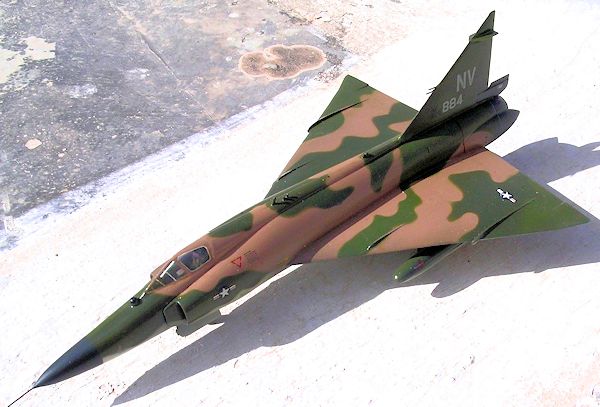 The
kit was made to represent an F-102A of the 57th
FIS. In 1972 special markings were added to drop tanks signifying high incidence
of encounter between ‘Black Knights’ and the Russian ‘Bear’. The knight’s shield
and rudder of the aircraft in this design match those of the unit’s F-102s.
The
kit was made to represent an F-102A of the 57th
FIS. In 1972 special markings were added to drop tanks signifying high incidence
of encounter between ‘Black Knights’ and the Russian ‘Bear’. The knight’s shield
and rudder of the aircraft in this design match those of the unit’s F-102s.
A
standard practice of ADC F-102s is to wear their squadron’s emblem on the left
side of the tail fin, while the ADC insignia appear opposite. Icelandic based
F-102s, of 57th FIS were easily
identified by this checked rudder. The pennant near the top of the fin was the
ADC ‘A’ award which recognized units that they distinguished themselves by
sustained operational effectiveness.
The
three-tone South East Asia colour scheme was introduced in the SEA theatre as
the name implies and this goes back to early 1966. War in SEAsia brought the
Delta Dagger to serve in combat and these came from the PACAF squadrons. Four
F-102s were first deployed at Clark Don Muang Airport outside Bangkok, Thailand
in 1961 to provide air defence to relieve a flight of six F-100 Super Sabres.
Early
participation in the VN conflict has began wartime operations in 1962 with
F-102s of 905 FIS. Ground fire at Da Nang air base destroyed three. By the end
of 1966 twelve F-102s stood alert in S Viet Nam Bien Hoa and Da Nang. F-102s
flew combat missions CAP escort for B-52 bombers. On one such mission, on the 3rd
of February 1968, two F-102s from 509th
were attacked by a pair of Mig-21s of north VN air Force. An Atoll missile fired
from a Mig shot one of the F-102s down.
 Twenty-Four
F-102s sent to Viet Nam performed a wide range of duties. Fifteen were lost
during its testimony of its lengthy involvement in the war. Eight of these were
operational losses, four during ground attacks, two downed by ground fire and
one shot down by a Mig-21. By mid 1970 the squadron was inactivated with
activities usually taken over by F4s.
Twenty-Four
F-102s sent to Viet Nam performed a wide range of duties. Fifteen were lost
during its testimony of its lengthy involvement in the war. Eight of these were
operational losses, four during ground attacks, two downed by ground fire and
one shot down by a Mig-21. By mid 1970 the squadron was inactivated with
activities usually taken over by F4s.
The camouflage on F-102s thwart
communist agents from tracking Air Force units on alert. My third model of the
Duce is in SEA camouflage that represents an aircraft from 82nd FIS based at
Naha air base in January 1968 where it was until 1971 hence the tail fin codes
NV. Those that were based at Bien Hoa had tail codes PK while those at Clark AB
1966-69 carried tail codes PE. I have used kit decals
for this model while Micro Scale decals were used on the other two.
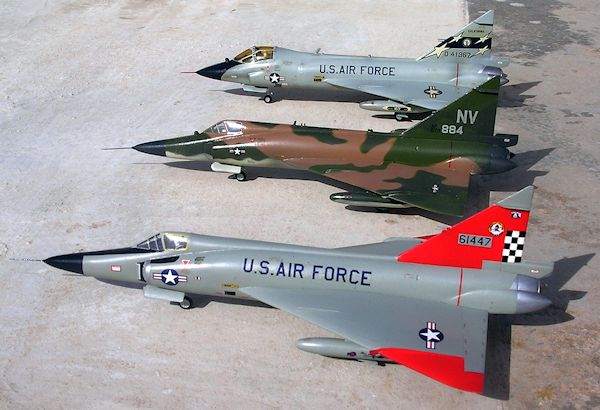 It
has been a long journey since the XF-92 first took to the air and the F-102 has
since served at a number of areas both in the northern and southern hemisphere
giving its share in developing air tactics during its time in warfare. Building
three models of the type in different liveries also seem to give a good
representation of its service history.
It
has been a long journey since the XF-92 first took to the air and the F-102 has
since served at a number of areas both in the northern and southern hemisphere
giving its share in developing air tactics during its time in warfare. Building
three models of the type in different liveries also seem to give a good
representation of its service history.
Ref: Convair
F-102 Delta Dagger by Wayne Mutza
Carmel J.
Attard
May 2013
If you would like your product reviewed fairly and fairly quickly, please
contact
the editor or see other details in the
Note to
Contributors.
Back to the Main Page
Back to the Review
Index Page



 This is
a Hasegawa kit; an old kit but is accurate in shape and outline. It is devoid of
panel lines and has raised ones instead. It also lacks certain detail in
particular to the nose wheel areas and bay inside detail. Landing gear was not
quite accurate to my liking and I preferred to replace with the metal landing
gear issued by SAC. Set SAC 72-2056 has an accurate straight nose gear leg and
nose gear wheel well detail. Some alterations may be required to fit the metal
undercarriage legs, which is self explained in the attached scrap views.
This is
a Hasegawa kit; an old kit but is accurate in shape and outline. It is devoid of
panel lines and has raised ones instead. It also lacks certain detail in
particular to the nose wheel areas and bay inside detail. Landing gear was not
quite accurate to my liking and I preferred to replace with the metal landing
gear issued by SAC. Set SAC 72-2056 has an accurate straight nose gear leg and
nose gear wheel well detail. Some alterations may be required to fit the metal
undercarriage legs, which is self explained in the attached scrap views. The
kit contains a complete weapon bay that has extended launch rails for six Falcon
AA missiles. These missiles are not accurate in shape and need replacement with
more accurate ones with added hinges to the
The
kit contains a complete weapon bay that has extended launch rails for six Falcon
AA missiles. These missiles are not accurate in shape and need replacement with
more accurate ones with added hinges to the ir
control fins. I have preferred to assemble my F-102 with a closed weapon bay.
Again there is a drawback in this case as the bay doors have a thin section and
would require spaced bulkheads or complete replacement with one built up from
thick plastic. I have opted to support them from the inside with spaced
bulkheads made from plastic and retained the same weapons bay doors.
ir
control fins. I have preferred to assemble my F-102 with a closed weapon bay.
Again there is a drawback in this case as the bay doors have a thin section and
would require spaced bulkheads or complete replacement with one built up from
thick plastic. I have opted to support them from the inside with spaced
bulkheads made from plastic and retained the same weapons bay doors. more
prominent radar hood was added to the cockpit coaming. The kit pitot tube was
too thin and fragile, and was replaced with one made of metal. Finally a slight
alteration was made to the wing tips to conform in shape to the close up photo I
had of same version.
more
prominent radar hood was added to the cockpit coaming. The kit pitot tube was
too thin and fragile, and was replaced with one made of metal. Finally a slight
alteration was made to the wing tips to conform in shape to the close up photo I
had of same version.

 Twenty-Four
F-102s sent to Viet Nam performed a wide range of duties. Fifteen were lost
during its testimony of its lengthy involvement in the war. Eight of these were
operational losses, four during ground attacks, two downed by ground fire and
one shot down by a Mig-21. By mid 1970 the squadron was inactivated with
activities usually taken over by F4s.
Twenty-Four
F-102s sent to Viet Nam performed a wide range of duties. Fifteen were lost
during its testimony of its lengthy involvement in the war. Eight of these were
operational losses, four during ground attacks, two downed by ground fire and
one shot down by a Mig-21. By mid 1970 the squadron was inactivated with
activities usually taken over by F4s.